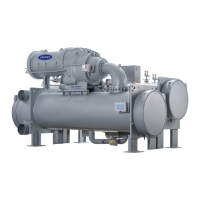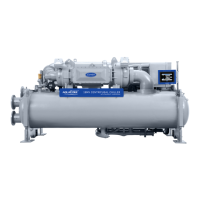21
Table 2 — Standard Instrumentation Sensors
A Refrigerant Saturation Temperature sensor (thermistor) is
located in the base of the evaporator, sensing refrigerant tem-
perature directly. Evaporator and condenser water side differ-
ential pressure transducers are not standard and are not re-
quired. The ICVC software uses the evaporator saturation re-
frigerant temperature in place of differential pressure flow
detection to provide evaporator freeze protection.
Approach temperatures are shown in the HEAT_EX screen.
EVAPORATOR APPROACH is defined as LEAVING
CHILLED WATER TEMPERATURE minus EVAPORATOR
REFRIGERANT TEMP (from the transducer). CONDENSER
APPROACH is defined as CONDENSER REFRIGERANT
TEMP (derived from condenser pressure) minus LEAVING
CONDENSER WATER temperature. When the chiller is run-
ning, the displayed value for either approach will not be less
than 0.2° F (0.1° C). If either approach value exceeds the value
configured in the SETUP1 screen, the corresponding Approach
Alert message will be entered into the ALERT HISTORY ta-
ble.
ICVC Operation and Menus (Table 3 and
Fig. 17-23)
GENERAL — The ICVC display automatically reverts to the
default screen after 15 minutes if no softkey activity takes place
and if the chiller is not in the pumpdown mode (Fig. 17).
If a screen other than the default screen is displayed on the
ICVC, the name of that screen is in the upper right corner (Fig.
18).
The ICVC may be set to display either English or SI units.
Use the ICVC configuration screen (accessed from the Service
menu) to change the units. See the Service Operation section,
page 63.
MODES
• LOCAL — In LOCAL mode the PIC II accepts com-
mands from the ICVC only and uses the local time occu-
pancy schedule to determine chiller start and stop times.
The PIC II can be placed in the local operating mode by
pressing the LOCAL softkey. When RUN STATUS is
READY, the chiller will attempt to start up.
• CCN — In CCN mode the PIC II accepts input from any
CCN interface or module (with the proper authority) as
well as from the local ICVC. The PIC II uses the CCN
time occupancy schedule to determine start and stop
TYPE LOCATION MONITORED REMARKS
TEMPERATURE
Entering Chilled Water Cooler Inlet Nozzle
Leaving Chilled Water Cooler Outlet Nozzle
Entering Condenser Water Condenser Inlet Nozzle
Leaving Condenser Water Condenser Outlet Nozzle
Evaporator Saturation Sensor Well on Bottom of Evaporator
Compressor Discharge Compressor Volute
Oil Sump Compressor Oil Sump
Compressor Thrust Bearing Redundant Sensor Provided
Motor Winding Redundant Sensor Provided
PRESSURE
Evaporator Relief Valve Tee
Condenser Relief Valve Tee
Oil Sump Compressor Oil Sump
Oil Pump Discharge Oil Pump Discharge Line
Diffuser (Compressor Internal) Only in Machines Equipped with Split Ring Diffusers
Entering Chilled Water (Optional) Cooler Inlet Nozzle
Leaving Chilled Water(Optional) Cooler Outlet Nozzle
Entering Condenser Water Condenser Inlet Nozzle
Leaving Condenser Water Condenser Outlet Nozzle
ANGULAR POSITION
Guide Vane Actuator Potentiometer Inside of Actuator
Split Ring Diffuser Actuator (only on split ring dif-
fuser equipped machines)
Potentiometer Inside of the Actuator (Split Ring Diffuser Position is
not Displayed on the ICVC)
PRESSURE SWITCH High Condenser (Discharge) Pressure Wired into the Starter Control Circuit
TEMPERATURE
SWITCH
Oil Pump Motor Winding Temperature Wired into the Oil Pump Control Circuit
Fig. 15 — Control Sensors (Temperature)
SHRINK WRAP
STRAIN RELIEF
1/8” NPT
THERMOWELL
REMOVABLE
TEMPERATURE
SENSOR
Fig. 16 — Temperature Sensor Used
with Thermal Well
a23-1624

